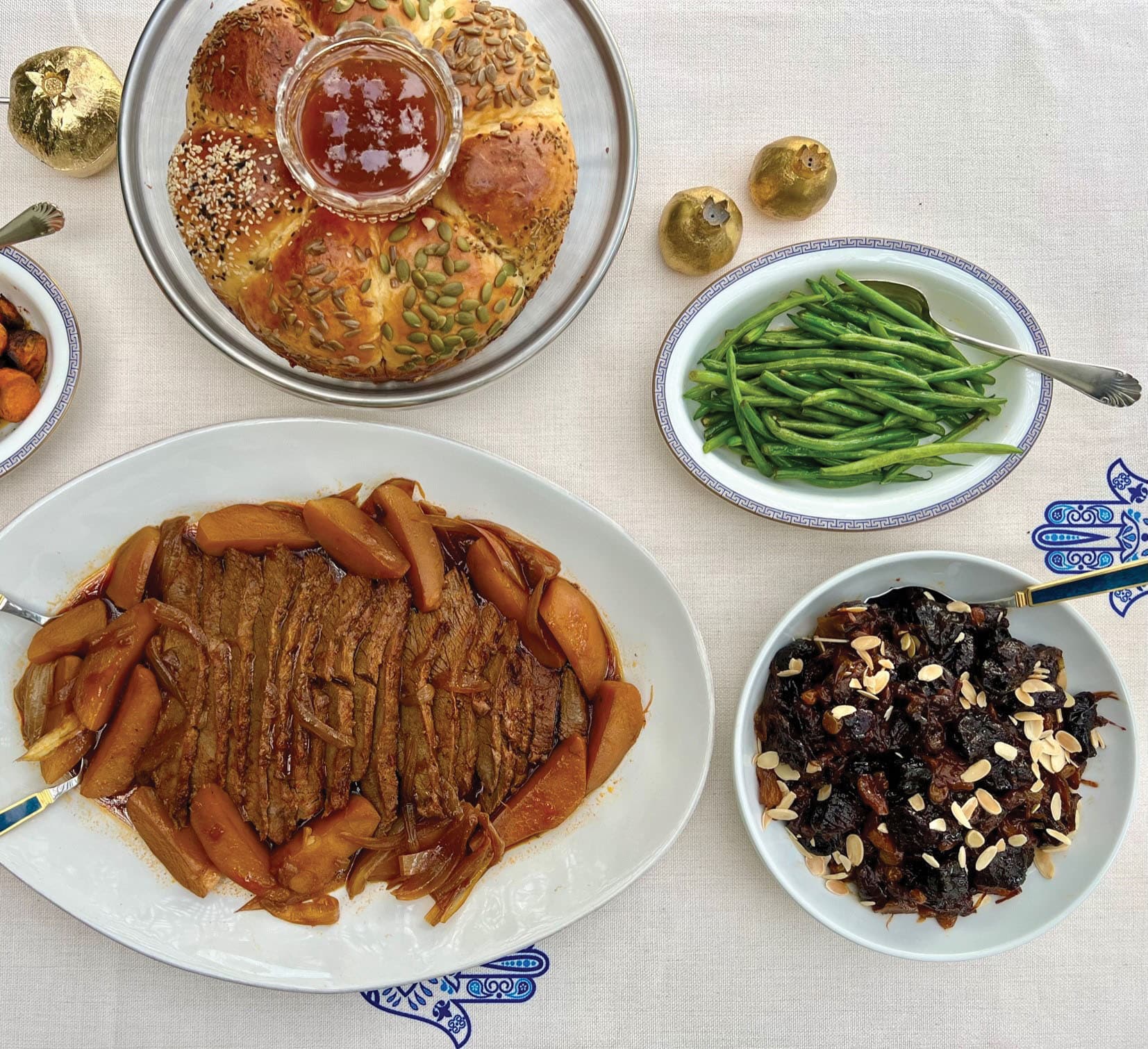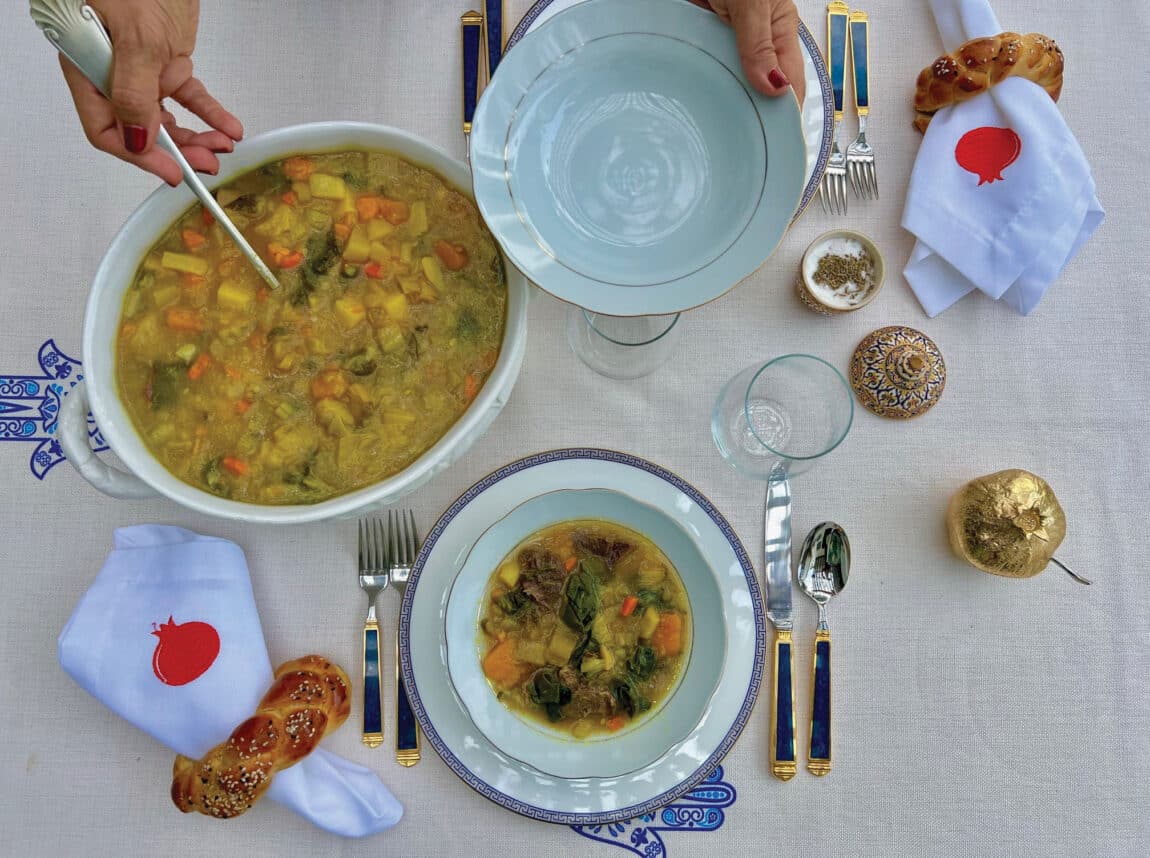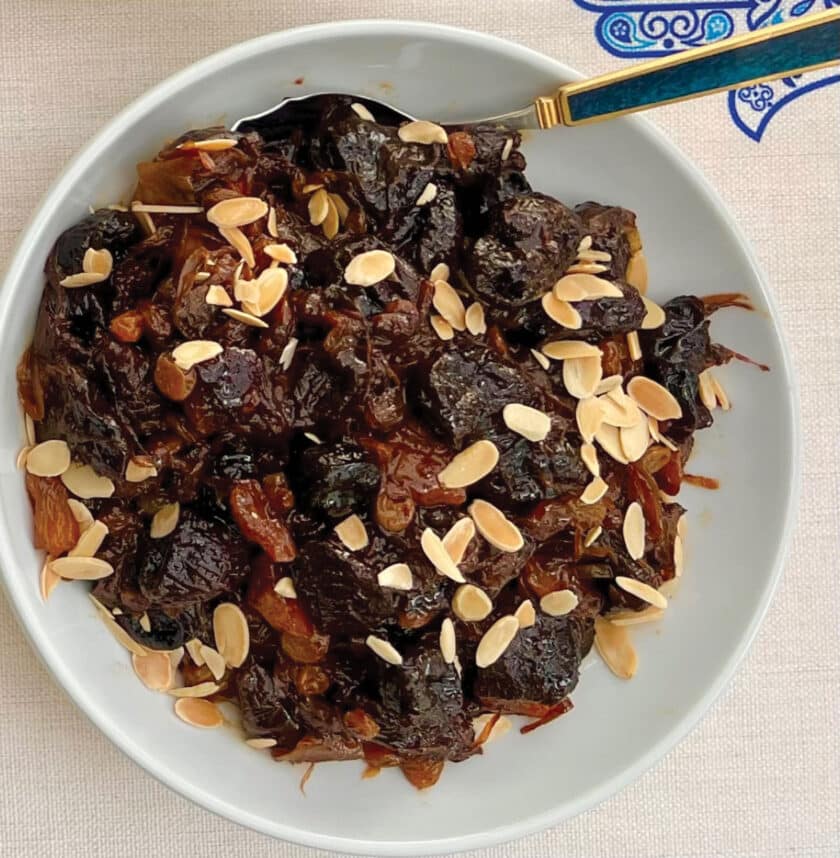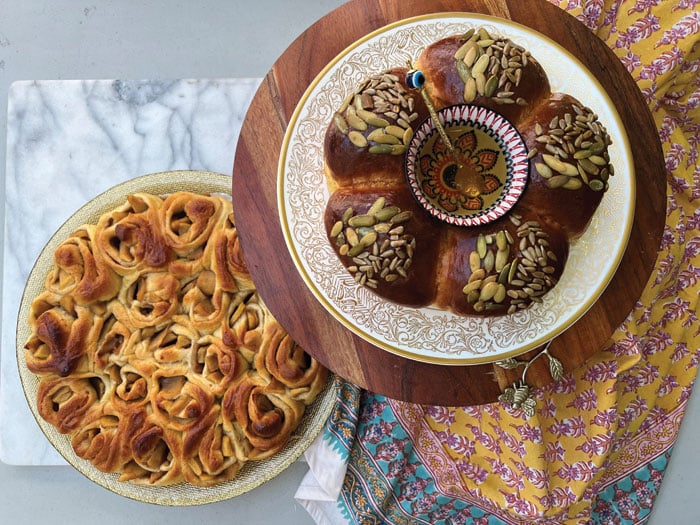
The holiness of Rosh Hashanah permeates the air. The candles burn brightly. We are all dressed in white. The table is covered with a white tablecloth, bedecked with flowers, apples and pomegranates and set with my mother’s beautiful pink and green floral English fine bone china. Each person has their own “seder” plate on which the blessings will be recited. First in Judeo-Arabic (an ancient language that predates Muslim rule in Babylonia), second in Hebrew and finally in English. The “Iraqit” reminds me of my great-grandparents and my grandparents whose ancestors lived for centuries in Baghdad and Al-Azair (where the tomb of Ezra the Scribe is located). The ancient Talmudists, who composed the Yehi Ratzon prayers and centered them around the foods that grow in abundance at that time of the year, lived in that region too.
On our plates are kar’a (stewed squash) and lubiyah (very long green beans), ruby red pomegranate and apple jam flavored with cardamom. There are spinach and leeks that will be ferociously ripped, to symbolize the tearing of any bad decrees and the destruction of our enemies. There are fresh yellow dates (bittersweet because they are my fathers favorite and this year will be our first Rosh Hashanah without him).
There will be a beef neck bone to symbolize “Akeidat Yitzchak” (sacrifice of Isaac). There will be red wine and round challah and lots of honey for a sweet New Year!
—Sharon
Every Rosh Hashanah we look ahead to a new year filled with blessings and good health. But for me when the high holidays arrive, all I can do is look back. Perhaps it is age. Perhaps it is because I write about food and history every week. Perhaps because I lost my mother this last year, I want to hold onto every memory possible. I think back on what I grew up eating, on the lessons my parents taught me and what I want my children to carry forward.
Tradition and memory influence my cooking and my way of life. But I’m not the only one who feels this way. Whenever Sharon and I post a typical, traditional old school Sephardic recipe on social media, we always get a huge reaction. So many people thank us for recording these recipes and keeping these memories alive. For many of our readers and followers, food transports them to the kitchens of their mothers and grandmothers.
Food is what connects us to our past, to our roots, to our traditions. There’s pure joy in the memory of tasting something that reminds us of something our mothers or grandmothers made when we were little. Many of us come from families that only one or two generations ago were displaced from their homes in the Middle East, in North Africa, in Europe, so food is a direct connection to the past, a direct line to the soul.
I feel blessed to share some of my family’s Spanish Moroccan culinary traditions for Roshana, (as Sephardim call it), as well as the flavors of my husband’s Rodesli background.
I always make “Dulce de Membrillo” (candied quince). Candied fruits and jams were a huge part of the “sweet table” in Morocco. My grandmothers made all sorts of preserves: fig, orange, quince, raisin, grapefruit. My mother would also make preserved fruits but as life in America became busier and health became a focus, she only made jams for the holidays. Candied quince was always on the table. The slices of exquisitely sweet fruit (which resembles an apple) were used as part of the blessings for the “simanim,” or “bocados” (bites) as they are called in Spanish.
Another sweet dish that was always on the table for special occasions and High Holy Days was made with prunes, caramelized onions, raisins and chopped up apricots. The apricot was my mother’s innovation, and this sweet and savory compote usually topped the festive couscous. This dish also serves as a fabulous accompaniment to brisket, roast beef, chicken and rice (and is amazing with lamb on Passover). While Moroccans do have a sweet tooth, this is a dish that everyone will love. I fondly remember packing a box every Roshana for Neil’s aunt Sylvia (who came from Rhodes)
When I married Neil, his Rodesli traditions became entwined with those of my family.
On the second night of Roshana, Neil reads all the “Yehi Ratsones” (blessings) in Hebrew, English and Ladino. He goes around the table, calling on each of the children to read. This lightens up the evening, giving our guests many laughs, as each one reads the unfamiliar Ladino words, struggling to pronounce them correctly. Even if our kids only learn a few words, it’s a precious way to keep the Ladino language alive in our family. It’s a memory they will always recall with a smile.
Both our families have the tradition of placing a small bowl of sugar on the table. On Roshana, we dip the “ha’motzi” in salt (to commemorate our eternal bond with G-d), then we dip the bread in sugar (for a sweet year). My mother always added anise (fennel seeds) on top of the sugar to add a beautiful aroma. Rodeslis save this sugar all year and if, G-d forbid someone has a bad scare or injury, you give the person a glass of water with a spoonful of the Roshana sugar stirred in to drink. “Agua kon asucar para quitar espantos” water to take away the effects of scares. Neil is always pushing this “potion” on us all, whether we want it or not, after any scare. Whether it be an earthquake, witnessing an accident, or any myriad of surprises life throws our way during the year — the Roshana sugar with water will make it all better. And so that’s what we’ve done since our very first Roshana together.
So while you look forward to your hopes and prayers for a sweet new year, take a moment to reflect on your past. What are the traditions that your family celebrated and passed on to you. I hope you preserve the sweetness of those memories and that they will carry you and your family into a wonderful year ahead and for always.
Shana Tova U’Metuka! Anyada Buena y dulse! To a good and sweet year!
—Rachel
Many of us come from families that only one or two generations ago were displaced from their homes in the Middle East, in North Africa, in Europe, so food is a direct connection to the past, a direct line to the soul.
Silan Stovetop Brisket
Traditional Babylonian dishes for the holidays would include semolina kubbah stuffed with ground lamb in a sweet and sour broth with okra and ma’hasha, a colorful array of meat and rice stuffed grape leaves, zucchini, tomatoes and onions. There would be moist chicken slow simmered in a fresh broth and pilau b’jij, a chicken and red rice dish garnished with crispy caramelized onion, slivered almonds and golden sultanas.
These dishes still grace my family table. But there is nothing easier and more delicious and crowd-pleasing than a brisket slow cooked with onions and potatoes.
This recipe gets great flavor from the spice rub and is really easy to prepare. In a nod to the simanim, I added Silan, a pure date honey, which lends just the right sweet, smoky notes to the meat.
Best of all it’s cooked on the stovetop, saving that precious oven real estate for your other dishes.
—Sharon
1 (4lb) brisket
Spice Rub
2 Tbsp sweet paprika
1 Tbsp smoked paprika
1 Tbsp mustard powder
1 Tbsp garlic powder
1 Tbsp coarsely ground black pepper
1 Tbsp brown sugar
1 Tbsp chicken consommé powder
Meat
2 Tbsp avocado or vegetable oil
2 large onions, peeled and chopped into eight wedges
10 cloves garlic, chopped
6 large potatoes, peeled and chopped into long wedges
2 cups red wine
2 cups water
2 Tbsp Silan (pure date syrup)
2 teaspoons salt
Preheat oven to 300°F.
In a bowl, combine spices, brown sugar and consommé to form a rub.
Sprinkle spice rub on both sides of the brisket.
Heat a wide, heavy bottomed pot over medium heat and add oil. Add the brisket and sear for five minutes. Flip the brisket and sear the other side.
Add the onions, garlic and potatoes around the brisket, then sauté for another five minutes.
Add the wine, water, Silan and salt and bring to a boil.
Lower the heat to a gentle simmer, cover the pot and cook for 3 to 4 hours until the meat is fork tender.
Let meat rest, then remove from the pot and slice.
Return the sliced meat to the pot and serve with juices.
MEMBRILLO-CANDIED QUINCE

10-12 small quinces
1 lemon, sliced
3-4 cups sugar
Juice of 1 lemon
Cinnamon stick or 2 tsp ground cinnamon (optional, to taste)
10-12 cloves (optional, to taste)
2 star anise (optional, to taste)
Juice of a small lemon
Wash quinces well, cut into slices, leaving skin on.
Place in large bowl with cold water and 1 lemon cut into slices.
In heavy-bottom pot, place sugar and juice of 1 lemon.
Discard water and place cut quinces into pot on top of sugar, stir to coat all slices.
Add cinnamon, cloves and star anise, cover pot, cook over medium heat.
As sugar and juices combine, stir from bottom up every 10 minutes.
After 30 minutes, reduce to simmer and cook 2 hours.
Uncover and cook additional 30 minutes so liquid starts to evaporate and thicken into syrup. Quinces will be dark red. (If there’s leftover syrup, it can be added to dafina (cholent), cocktails or atop ice cream.)
Refrigerate up to 1 month.
Sopa de Roshana – Simanim Soup

My mother Rica always made the most delicious, most nourishing and most satisfying soups. But for Rosh Hashana there was a special soup. This soup contained all the vegetables of the “simanim” on which one needs to say blessings. This is a Spanish Moroccan custom. Not only are all the vegetables in there but there’s also cheek meat or neck bones to symbolize the sheep’s head. My mother would chop up the vegetables and leave part of them in bigger pieces. Then she would simmer all the vegetables and meat together. She would serve the larger pieces with honey on top for the blessings and the soup would be served as the first course. As a child, this was definitely not one of my favorite things to eat. My brothers and cousins all made faces but we ate it anyways. We knew you had to eat it if you wanted this to be a good year for you.
With time, this soup became vegetarian as my brothers didn’t eat meat. And over time we became more creative in serving the simanim, so we didn’t have to swallow the boiled veggies with honey anymore.
This year I am all about honoring my mother’s recipes. I have decided to make this very delicious soup from my youth. I will cook the meat cheeks in my pressure cooker separately and will add it for those who wish to have meat in their bowl. This way everyone will be able to have Maman’s Roshana soup.
This recipe makes a very large pot, so you should have enough to serve for the two nights.
—Rachel
Meat:
3-4 lb cheek meat
¼ cup olive oil
One large onion finely diced
2 bay leaves
1 tsp salt
½ tsp white pepper
Pinch of saffron (optional)
1 cup water
Soup:
¼ cup olive oil
4 leeks, washed thoroughly and sliced thinly
1 bunch Swiss Chard, with stem removed and chopped thinly
2 cups butternut squash, cubed
1 large green apple or quince, peeled and cubed
2 large zucchini, peeled and diced
2 small sweet potatoes, peeled and cubed
4 medium Yukon gold potatoes, peeled and cubed
1 large turnip, peeled and cubed
4 celery stalks, diced
3 large carrots, peeled and diced
2 parsnip, peeled and diced
½ small cabbage, thinly sliced
2 Tbsp chicken consommé powder
½ tsp white pepper
1 teaspoon turmeric
Salt to taste
Meat:
In pressure cooker or large pot, add oil and warm over medium heat. Add onion and sauté for 5 minutes.
Add meat, bay leaf and spices. Cook for one hour in pressure cooker or until tender in the pot.
Soup:
In a very large pot warm oil over medium heat, then add sliced leeks. Sauté for 5 minutes until they start to soften.
Add all the ingredients, except Swiss chard, zucchini and butternut squash. Set aside the Swiss chard, zucchini, and butternut squash.
Pour enough water to cover the top of the vegetables. Cover the pot and simmer on medium heat.
Bring to a boil, then lower heat to a simmer.
Cook vegetables for an hour. Add the zucchini and butternut squash. Simmer for another half hour and add the Swiss chard , continue to cook on a simmer for an additional 30 minutes.
Taste and adjust seasoning.
MOROCCAN CARAMELIZED ONIONS, PRUNES, RAISINS, APRICOTS

4 large yellow onions
1/4 cup avocado or vegetable oil
3-4 cups soft pitted prunes
1 cup of dark or golden raisins
½ cup chopped dried apricots.
Rind of one orange
¼ cup orange juice
1 tsp of cinnamon
3 cloves (optional)
¼ cup Silan (pure date syrup)
¼ cup honey
¼ cup of toasted almond slices, for garnish
Using a food processor or mandolin, slice onions thinly.
Warm oil in a large casserole pot over medium heat and add onions. Sauté the onions and stir continually until soft and golden.
Add the prunes, raisins, apricots, orange rind, orange juice, cinnamon, silan and honey and stir well.
Cover pot, lower heat and simmer for 30 to 40 minutes, making sure not to burn the mixture on the bottom of the pot. If mixture appears too dry, add a little water.
Garnish with toasted, sliced or slivered almonds.
Let’s Break Bread

Nicole Saghian has always had an affinity for challah and its symbolism of peace, family, and tradition. But it wasn’t until the pandemic hit that she felt inspired to begin baking it myself. While she was lucky enough to be able to continue working her full-time job as an assistant Speech Language Pathologist via Zoom, she had spare time on her hands. She decided to play around with various challah recipes. She found that the process of kneading dough enhanced her spiritual connection and provided a therapeutic escape. Soon enough, baking homemade challah for Shabbat became a weekly tradition. She started delivering them to the doorsteps of friends and family each week. They encouraged her and soon enough, Nicole turned her creative outlet into a small business selling baked goods to the greater Los Angeles community. Breaking Bread with Nic was born.
What started out as a single traditional challah recipe has turned into a menu of over 15 variations of stuffed challah (some popular flavors include green olive and rosemary, grilled onions with jalapeño and Kalamata olives, Nutella oreo, and spinach with feta). During the high holidays, she introduces cakes to her menu, with the apple tart, gluten-free lemon olive oil cake, and Persian love cake being in high demand.
“The interactions I’m able to have within my client base through my small business has been such a blessing for me. Having people send in names to pray for during Hafrashat challah has given me such a sense of purpose and connectedness to the community, and it feeds my soul in ways I didn’t know I needed,” she told us. “Most of all, it brings me much joy knowing that something I made with my bare hands, out of pure love, is sitting on so many Shabbat tables as friends and family break bread together.”
Her favorite Rosh Hashanah tradition is their family Seder. “Each blessing is read in Hebrew, English, and Farsi, extracting from all our family’s roots and instilling our culture in the younger generation.”
Nicole adds “In recent years, my dad has begun reading his own version of the blessings in a Farsi rhyming poetry song. Everybody claps and sings along, and it truly adds so much laughter, joy and sweetness to our Rosh Hashanah table.”
In an effort to pay it forward, each month Nicole donates a portion of her proceeds to a different charity. Her September charity of the month is Lovengroceries, a local organization geared towards raising funds to help support widows and children in our community.
We met Nicole as part of a Los Angeles foodie Instagram bloggers that united around Ellie’s Great Big Challah Bake. A unique project bringing people together to pray for the speedy recovery of a young sick girl Ellie Ruby.
We’re so pleased to share Nicole’s delicious recipe for Apple Blossom Rolls. So pretty and so yummy, you’ll make them again and again.
We’re so pleased to share her delicious recipe for Apple Blossom Rolls. So pretty and so yummy, you’ll make them again and again.
To order simply follow Nicole on Instagram @breakingbreadwithnic and send her a message.
Apple Blossom Rolls
Dough
2 Tbsp yeast + 1 tsp sugar
6 cups flour
½ cups sugar
2 eggs
½ cup oil
1 tsp salt
1 ½ cups water
Combine dry yeast, warm (120°F) water, 1 teaspoon sugar in a glass bowl and set aside to proof 10 minutes.
In a large bowl, combine all of the flour with remaining sugar and salt, the proofed yeast water. Add the eggs, and oil. Mix well, cover and let rise for an hour.
Apple filing:
Peel and slice 3-4 large apples, sprinkle cinnamon and brown sugar and cook for about 20 minutes on medium until apples are brown in color and soft.
Once dough is proofed, roll it out to make a rectangle. Sprinkle with cinnamon brown sugar and layer 2 rows of apple filling. Roll up the dough into a log and cut into 20 even pieces. Place in a 12-inch round aluminum pan and bake at 350°F for 38-40 minutes.
Sharon Gomperts and Rachel Emquies Sheff have been friends since high school. The Sephardic Spice Girls project has grown from their collaboration on events for the Sephardic Educational Center in Jerusalem. Follow them
on Instagram @sephardicspicegirls and on Facebook at Sephardic Spice SEC Food. Website sephardicspicegirls.com/full-recipes.























 More news and opinions than at a Shabbat dinner, right in your inbox.
More news and opinions than at a Shabbat dinner, right in your inbox.